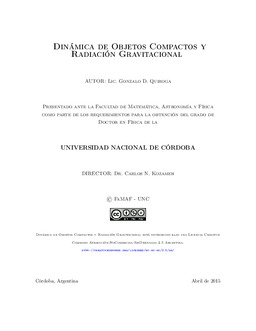| dc.contributor.advisor | Kozameh, Carlos Nicolás | |
| dc.contributor.author | Quiroga, Gonzalo Damián | |
| dc.date.accessioned | 2016-07-05T16:52:45Z | |
| dc.date.available | 2016-07-05T16:52:45Z | |
| dc.date.issued | 2015-04 | |
| dc.identifier.uri | http://hdl.handle.net/11086/2790 | |
| dc.description | Tesis (Doctor en Física)--Universidad Nacional de Córdoba. Facultad de Matemática, Astronomía y Física, 2015. | es |
| dc.description.abstract | En esta tesis haciendo uso de la estructura asintótica del espaciotiempo y del formalismo de Newman-Penrose definimos la noción de centro de masa y spin para sistemas gravitacionales que emiten radiación gravitacional y electromagnética. A diferencia de otras formulaciones disponibles en la literatura, una de las características centrales de nuestro formalismo es el uso de cortes reales de Newman-Unti que son generados por líneas mundo del espaciotiempo. A partir de estos cortes se obtienen las ecuaciones para el momento angular y el momento dipolar másico, estas ecuaciones son similares con su contraparte newtoniana a pesar de que en nuestra formulación estas cantidades han sido definidas utilizando variables en la frontera nula de un espaciotiempo asintóticamente plano. Finalmente derivamos las ecuaciones que vincula la evolución temporal del momento dipolar másico y el momento angular con la radiación gravitacional emitida y encontramos la ecuación de movimiento para el centro de masa del sistema. | es |
| dc.description.abstract | In this thesis we define the notion of center of mass and spin for gravitational systems that emits gravitational and electromagnetic radiation, to do this we use the asymptotic structure of the spacetime and the Newman-Penrose formalism. Unlike other approaches, a central feature in our formulation is the use of real Newman-Unti cuts at
null infinity that are generated by worldlines of the spacetime. From these cuts we obtain the equation for the angular momentum and mass dipole, these equations are similar to their Newtonian counterparts although in our formulation these amounts have been defined using only variables at the null boundary of an asymptotically flat spacetime.
Finally we derive equations linking their time evolution to the emitted gravitational radiation and also we get the equation of motion for the center of mass of the system. | |
| dc.language.iso | spa | es |
| dc.rights | Atribución-NoComercial-SinDerivadas 2.5 Argentina | * |
| dc.rights.uri | http://creativecommons.org/licenses/by-nc-nd/2.5/ar/ | * |
| dc.subject | Relatividad general clásica | es |
| dc.subject | Classical general relativity | es |
| dc.subject | Asymptotic structure | es |
| dc.subject | Gravitational waves | es |
| dc.subject | Einstein-Maxwell spacetimes | es |
| dc.subject.other | Teoría de Einstein-Maxwell | |
| dc.subject.other | Espaciotiempo | |
| dc.title | Dinámica de objetos compactos y radiación gravitacional | es |
| dc.type | doctoralThesis | es |





